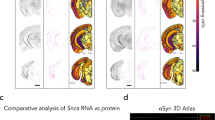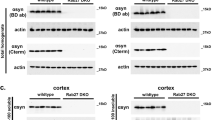Abstract
Dentatorubral–pallidoluysian atrophy (DRPLA) is associated with the expansion of an unstable GAG repeat. Using antibodies against a synthetic peptide corresponding to the sequence of the DRPLA gene product C terminus, we have identified the DRPLA gene product in normal human brains as a ≈190 kD protein. We also find a larger ≈205 kD protein specifically in DRPLA brains. Immunohistochemically, the DRPLA gene product is observed mainly in the neuronal cytoplasm. Our results demonstrate the existence of the expanded GAG repeat gene product and support the possibility that the expanded CAG–encoded polyglutamine stretch may participate in the pathological process of the similar trinucleotide repeat diseases.
This is a preview of subscription content, access via your institution
Access options
Subscribe to this journal
Receive 12 print issues and online access
$209.00 per year
only $17.42 per issue
Buy this article
- Purchase on Springer Link
- Instant access to full article PDF
Prices may be subject to local taxes which are calculated during checkout
Similar content being viewed by others
References
Smith, J.K., Gonda, V.E. & Malamud, N. Unusual form of cerebellar ataxia: combined dentato-rubral and pallido-Luysian degeneration. Neurology 8, 205–209 (1958).
Naito, H. & Oyanagi, S. Familial myoclonus epilepsy and choreoathetosis: hereditary dentatorubral-pallidoluysian atrophy. Neurology 32, 798–807 (1982).
Takahashi, H. et al. Hereditary dentatorubral-pallidoluysian atrophy: clinical and pathological variants in a family. Neurology 38, 1065–1070 (1988).
Sano, A. et al. Anticipation in hereditary dentatorubral-pallidoluysian atrophy. Hum. Genet. 93, 699–702 (1994).
Burke, J.R. et al. The Haw River syndrome: dentatorubropallidoluisian atrophy(DRPLA) in an African-American family. Nature Genet. 7, 521–524 (1994).
Komure, O. et al. DNA analysis in hereditary dentatorubal-pallidoluysian atrophy: correlation between CAG repeat length and phenotypic variation and the molecular basis of anticipation. Neurology 45, 143–149 (1995).
Kondo, I. Exclusion mapping of the hereditary dentatorubropallidoluysian atrophy gene from the Huntington's disease locus. J. med. Genet. 27, 105–108 (1990).
Li, S.H., Mclnnis, M.G., Margolis, R.L., Antonarakis, S.E. & Ross, C.A. Novel triplet repeat containing genes in human brain: cloning, expression, and length polymorphisms. Genomics 16, 572–579 (1993).
Koide, R. et al. Unstable expansion of CAG repeat in hereditary dentatorubral-pallidoluysian atrophy (DRPLA). Nature Genet. 6, 9–13 (1994).
Nagafuchi, S. et al. Dentatorubral and pallidoluysian atrophy expansion of an unstable CAG trinucleotide on chromosome 12p. Nature Genet. 6, 14–18 (1994).
Fu, Y.H. et al. Variation of the CGG repeat at the fragile X site results in genetic instability: resolution of the Sherman paradox. Cell 67, 1047–1058 (1991).
Verkerk, A.J. et al. Identification of a gene (FMR-1) containing a CGG repeat coincident with a breakpoint cluster region exhibiting length variation in fragile X syndrome. Cell 65, 05–914 (1991).
Fu, Y.H. et al. An unstable triplet repeat in a gene related to myotonic muscular dystrophy. Science 255, 1256–1258 (1992).
La Spada, A.R., Wilson, E.M., Lubahn, D.B., Harding, A.E. & Fischbeck, K.H. Androgen receptor gene mutations in X-linked spinal and bulbar muscular atrophy. Nature 352, 77–79 (1991).
The Huntington's Disease Collaborative Research Group. A novel gene containing a trinucleotide repeat that is expanded and unstable on Huntington's disease chromosomes. Cell 72, 971–983 (1993).
Orr, H.T. et al. Expansion of an unstable trinucleotide CAG repeat inspinocerebellar ataxia type 1. Nature Genet. 4, 221–226 (1993).
Knight, S.J. et al. Trinucleotide repeat amplification and hypermethylation of a CpG island in FRAXE mental retardation. Cell 74, 127–134 (1993).
Kawaguchi, Y. et al. CAG expansions in a novel gene for Machado-Joseph disease at chromosome 14q32.1 Nature Genet. 8, 221–228 (1994).
Parrish, J.E. et al. Isolation of a GCC repeat showing expansion in FRAXF, a fragile site distal to FRAXA and FRAXE. Nature Genet. 8, 229–235 (1994).
Pieretti, M. et al. Absence of expression of the FMR-1 gene in fragile X syndrome. Cell 66, 817–822 (1991).
Verheij, C. et al. Characterization and localization of the FMR-1 gene product associated with fragile X syndrome. Nature 363, 722–724 (1993).
Fu, Y.H. et al. Decreased expression of myotonin-protein kinase messenger RNA and protein in adult form of myotonic dystrophy. Science 260, 235–238 (1993).
van der Ven, P.F. et al. Myotonic dystrophy kinase is a component of neuromuscular junctions. Hum. molec. Genet. 2, 1889–1894 (1993).
Strong, T.V. et al. Widespread expression of the human and rat Huntington's disease gene in brain and nonneural tissues. Nature Genet. 5, 259–265 (1993).
Li, S.H. et al. Huntington's disease gene (IT15) is widely expressed in human and rat tissues. Neuron 11, 985–993 (1993).
Hoogeveen, A.T. et al. Characterization and localization of the Huntington disease gene product. Hum. molec. Genet. 2, 2069–2073 (1993).
Mhatre, A.N. et al. Reduced transcriptional regulatory competence of the androgen receptor in X-linked spinal and bulbar muscular atrophy. Nature Genet. 5, 184–188 (1993).
Willems, P.J. Dynamic mutations hit double figures. Nature Genet. 8, 213–215 (1994).
Nagafuchi, S. et al. Structure and expression of the gene responsible for the triplet repeat disorder, dentatorubral and pallidoluysian atrophy(DRPLA). Nature Genet. 8, 177–182 (1994).
Query, C.C., Bentley, R.C. & Keene, J.D. A common RNA recognition motifidentified within a defined U1 RNA binding domain of the 70K U1 snRNP protein. Cell 57, 89–101 (1989).
Matsuura, T. et al. Androgen receptor abnormality in X-linked spinal and bulbar muscular atrophy. Neurology 42, 1724–6 (1992).
Ashley, C., Jr., Wilkinson, K.D., Reines, D. & Warren, S.T. FMR1 protein: conserved RNP family domains and selective RNA binding. Science 262, 563–566 (1993).
Devys, D., Lutz, Y., Rouyer, N., Bellocq, J.P. & Mandel, J.L. The FMR-1 protein is cytoplasmic, most abundant in neurons and appears normal in carriers of a fragile X premutation. Nature Genet. 4, 335–340 (1993).
Author information
Authors and Affiliations
Rights and permissions
About this article
Cite this article
Yazawa, I., Nukina, N., Hashida, H. et al. Abnormal gene product identified in hereditary dentatorubral–pallidoluysian atrophy (DRPLA) brain. Nat Genet 10, 99–103 (1995). https://doi.org/10.1038/ng0595-99
Received:
Accepted:
Issue Date:
DOI: https://doi.org/10.1038/ng0595-99
This article is cited by
-
Whole-exome sequencing identifies novel candidate predisposition genes for familial polycythemia vera
Human Genomics (2017)
-
Focal Nature of Neurological Disorders Necessitates Isotype-Selective Histone Deacetylase (HDAC) Inhibitors
Molecular Neurobiology (2009)
-
The roles of proteolysis and nuclear localisation in the toxicity of the polyglutamine diseases. A review
Neurotoxicity Research (2005)



